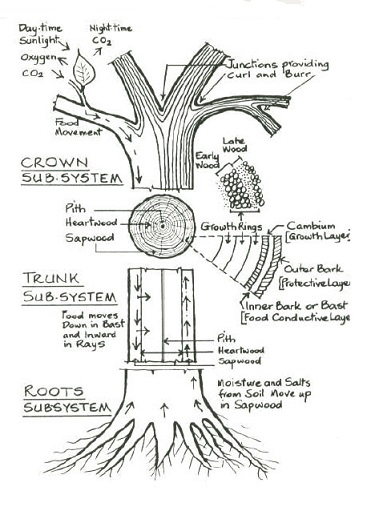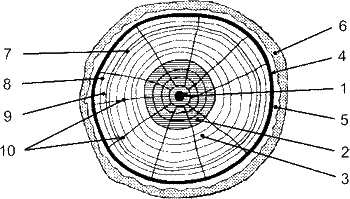Tree Wuchs - Hardwood/Softwood
 |
Tree trunks and branches grow thicker as new cells are added beneath the bark. These cells make up vessels, called xylem and phloem, that carry water and food throughout the tree. Xylem carries water and nutrients from the roots up to longer carries water. It forms the heartwood of the tree and may be a different color from the sapwood. Phloem, also called inner bark, carries food from the leaves to the branches, trunk and roots. Outside the phloem is the outer bark, which protects the tree from injury.The cambium is found between the phloem and xylem. If you looked at a tree stump, you could not see the cambium, because it is only one cell layer thick. The cambium’s job is to make new xylem and phloem cells. Tree roots grow from specialized tissue at their tips. Roots anchor a tree in the soil and absorb the water and nutrients a tree needs. Most of a tree’s roots are found in the top two feet of soil, even when the tree is very large. Root hairs near the growing tips take in water from the soil. You’d need a microscope to see these tiny, tubelike hairs; yet, in a large tree, they can absorb hundreds of gallons of water each day. Surprisingly, only a small amount of this water is used in photosynthesis. The rest is released from the leaves in a process called transpiration. |
Wood begins as a natural resource and passes along the production chain until it is converted into end user products. Wood construction is common for many single-family houses throughout the world. In areas where timber and wood materials are easily accessible, timber construction is often considered to be the cheapest and best approach for residential housing structures. Timber framing is a versatile, environmentally sustainable method of construction.
The design of residential timber framed construction must comply with AS1684. For other timber engineering stuctures the design code AS1720 is applicable.
 |
1 Pith 2 Hartwood 3 Sapwood 4 Cambuim Layer 5 Bast |
6 Bark 7 Annual Rings 8 Sping growth 9 Autumn growth 10 Medullary Rays |
How a Tree works.
- The Bark is the tree's protection from the outside world. It keeps moisture out during rain, prevents loss of moisture
- The Bast is the pipeline through which the when the air is dry, insulates against cold and heat, and wards off insects food (Elaborated Sap) produced in the leaves is passed down to the tree. It lives for only a short time then dies and turns to Bark.
- The Cambium layer is the growing part of the tree trunk. It annually produces new Sapwood on the inside and some Bast on the outside.
- Sapwood is the tree's pipeline for moving water and minerals up the tree trunk to the leaves. Sapwood is new wood; as newer rings of Sapwood are produced, its inner cells lose their vitality and turn into Heartwood.
- Heartwood is the central, supporting pillar of the tree. Although dead, it will not decay or lose strength while the outer layers are intact.
Softwood - Hardwood
The terms ‘softwood’ and ‘hardwood’ do not indicate softness or hardness of particular timbers. In fact, some hardwoods are softer and lighter than softwoods. The main differences between hardwoods and softwoods are botanical, and relate to the way the tree grows.
Cell Structure of Softwood and Hardwood
Wood, instead of being a relatively solid material like steel or concrete, is basically composed of many tubular fiber units, or cells, cemented together. Many properties of wood are related directly to its structure.

FIGURE 1

The essential difference between the wood from hardwoods and softwoods is the presence of vessels in hardwoods as shown in the above diagrams. These are continuous pipes running the length of the tree and serve as conduits for water and nutrients in the outer layers of wood in a growing tree. In hardwoods, the cells are closed and cannot function as conduits. In softwoods, the cells have openings to other cells. This means the cells are the nutrient conduits. The actual cells in the softwood species have the same function as the vessels in hardwoods. The open cell structure of softwoods makes them generally more receptive than hardwoods to preservative treatments to enhance durability.
Strength and Stiffness (Example straw model)
As can be seen in Figure 1 & 2 the wood structure is dominated by longitudinal cells, with only a few transverse cells bundling them together, one can model the microstructure of wood using the using drinking straw bound loosely together by elstic bands (class demonstration). As has been demonstrated timber has a good longitudinal tensile strength and very low tensile strength to the grain as shown in the picture below.

Shrinkage
Shrinkage is a defect, and generally a natural defect, occurring during the seasoning process. When timber is seasoning it dries below its fibre-saturation point, it shrinks. However, the loss in dimension is not the same in all directions. Timber shrinks in three directions:
|
| These differential rates of shrinkage have considerable effect on the performance of timber in service. When it's moisture content (MC) is reduced below the Fibre Saturated Point (FSP) continued drying will cause dramatic change such as increase in strength but also distortion and shrinkage. Shrinkage is the greatest tangentially over the radial direction with little loss along the grain length. However, when the amount of shrinkage takes place in an uncontrolled way, the risk of splitting the timber increases significantly. (see Figure 4) |
 FIGURE 4 FIGURE 4
|
close page if not needed